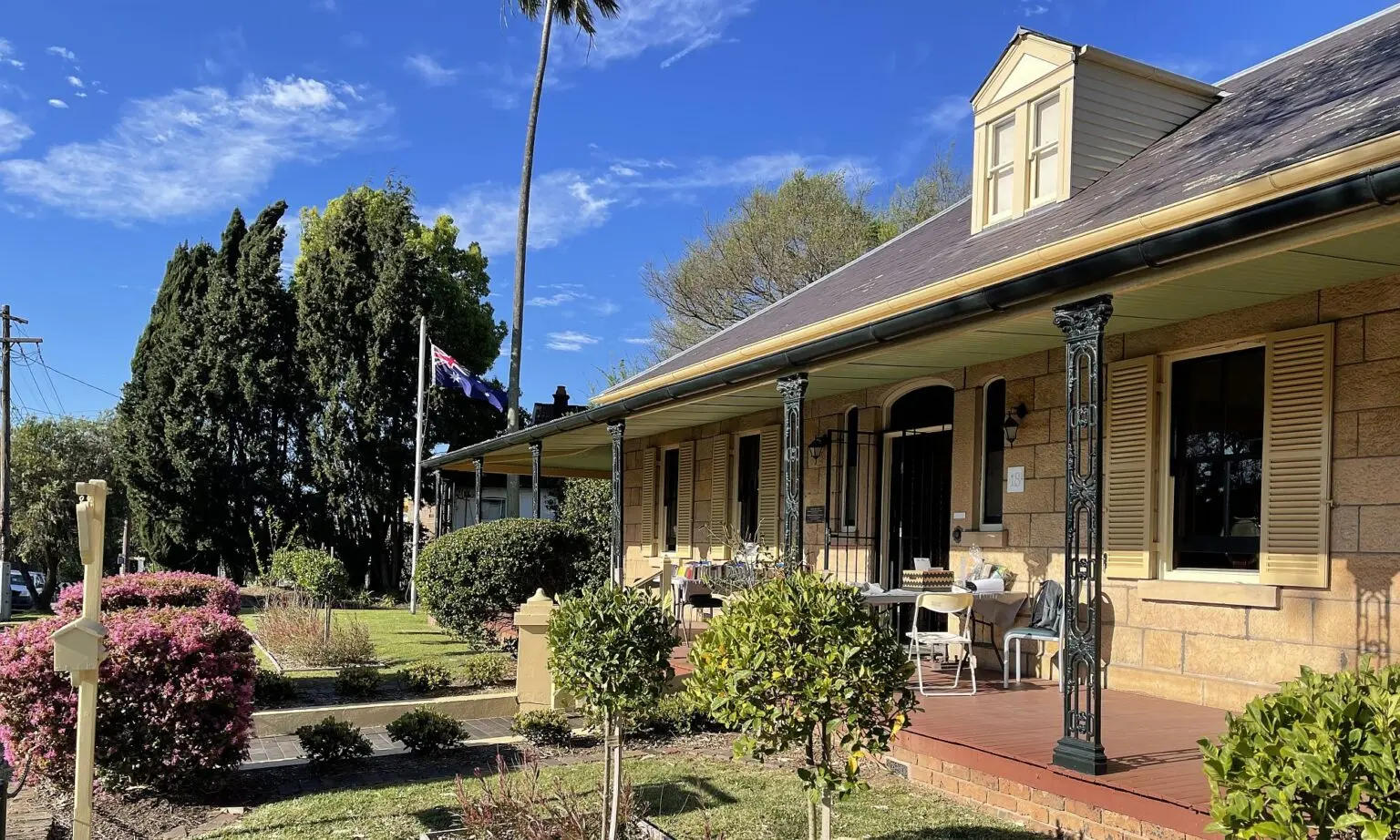by Mary Barthelemy*

St Magdalen’s Tempe was an offshoot of the Good Samaritan Sisters’ House of the Good Shepherd in Sydney’s Pitt Street. Destitute women, including former prostitutes, were cared for in this refuge from the Order’s beginnings in the mid-19th century. Laundries were features of these establishments as they had a dual function – to help the women and provide a regular income to support the institution. These ‘fallen women’, ‘penitents’, are the subject of the ABC Radio National program The Missing Magdalens.
The ABC illustrated the first version of the program (19 July 2023) with an image of a young girl in a messy, depressing laundry. Whether the girl worked at this unidentified Irish laundry, whether it was Catholic or Protestant, is unknown.1 But, it suited the story they wanted to tell.2 The program used reports about Irish Magdalen laundries to sensationalise its story about St Magdalen’s. In the revision, published mid-November 2023 (August 2023 ABC website), this has been replaced by a picture of the real St Magdalen’s laundry c1980.
The narrator, Donna Abela, gives a particular slant to the story of the penitents – especially in her search for a voice from one of the ‘hidden’ women. She presents May Gould as such a voice. Gould’s misleading claims about working in the Retreat’s laundry in 1906 were widely disseminated in The Watchman; later repudiated by her former supporters.3 It is a travesty that nearly 120 years later these are presented as a ‘factual account’. One of Gould’s assertions, that three nine-year-old girls were working in the laundry, was highlighted in the broadcast. In her rebuttal, Mother Dominic stated that the youngest there in fact was 14 and a family placement.4 Another was that she had worked in a Bathurst presbytery (she had not). The list goes on. (Details are given in Jeff Kildea’s article, ‘”The Missing Magdalens’: the ABC resurrects a ‘hidden story’ discredited more than a century ago”.) The story has been retained and its use defended.

Australian Town and Country Journal 10 June 1899.
Listening to this program, particularly the story of ‘the penitent’, I realised that I first encountered it in recent research.5 This prompted another look at the history of St Magdalen’s. By highlighting the so-called ‘hidden voice’ and restricting the discussion to the institution’s earliest phase – up to the first decades of the 20th century – the one most removed from modern society, the broadcast, even in its current form, continues to do a disservice to many girls and women, including the Religious, who lived there.6
St Magdalen’s was a part of my childhood in the 1960s and early 70s. I had a privileged experience. My father was in charge of the grounds. When I was in primary school and into my teenage years I spent some time in the holidays there. I rarely saw the girls but I do remember one, perhaps 16+, quietly sweeping the paths near the chapel on one visit. Not only was I free to explore the grounds at the front but I was permitted to use the swimming pool (I had a hearing condition). I fondly remember ‘Rosie’ calling out, “Hello Mary Angela” followed by an echo from someone else … the many styles and colours of the swimming costumes hanging in the dressing room. I recall the convent as a place of welcome and many of the Sisters, including Sister Process us (Sister Mary Gregory); the kitchen at the rear of the house – the aroma of decades of cooking baked into the plaster.7 It was there still in the early 1990s at an open day for Tempe House organised by the local historical society. The scent of the cedar ceiling in the chapel remained though the furnishing was sadly derelict. By that time the large buildings had been demolished following a fire – a few years after the Sisters sold the property to Qantas (1989).
The Order hoped the site could be developed into aged living, like the Good Shepherd Sisters’ Ashfield laundry, but Rockdale Council rejected this. A small group of Vincentians lived there for a few years. Qantas eventually sold it: enormous change followed. The front paddock was used in the construction of the airport railway line. Wolli Creek station was built and the surrounding area developed into what is seen today – high-rise residential buildings. What little remained of the laundry was not considered valuable built heritage, was demolished and replaced by multi-storey apartments. Tempe House was the focus of heritage restoration and also the chapel.8 A plaque near the chapel provides a brief outline of the Retreat and the chapel’s architectural heritage. ‘Wolli Creek’ replaced ‘Arncliffe’.
There is another story to tell. In St Magdalen’s 100 years tremendous changes occurred – more subtle than the foregoing but change nonetheless. This article can only be a sketch of such a long and complex record. A knowledge of local history situates this institution in a new context and offers some insights into its place in the local community.
Continue reading in the Journal of the Australian Catholic Historical Society, vol 44, 2023, page 22.
* Mary Barthelemy has an interest in researching and writing about history. She is currently employed as a public servant. This article is based on the author’s recollections, parish history and research as well as recent independent examination.
- Unidentified Magdalen Laundry in Ireland early 20th century https://en.wikipedia.org/wiki/Magdalene Laundries in Ireland. ↩︎
- Australian Town and Country produced a story and a two-page spread with photos of the Tempe laundry, dormitory, dining room, chapel, house and grounds in 1899. It also appears to be a source for some of the restoration of Tempe House. There are two laundry interiors either of which could have been used. “St Magdalen’s Retreat, Tempe” Australian Town and Country Journal 10 June 1899 p 31 ff. ↩︎
- “The Bathurst Presbytery and the Tempe ‘Escapee’: a retraction by Dr Dill Macky” National Advocate 6 August 1906 p 2. Her former supporters were not afraid to class her a liar and in print. ↩︎
- “A Shameless Slander Exposed” Freeman s Journal 14 July 1906 p 17. ↩︎
- I intend to update this book: M Smith, M Barthelemy-Reason, A History of Sts Peter & Paul Cook’s River Tempe 1858-2008 Enmore-Tempe Parish, Enmore, 2008. ↩︎
- For all the program’s emphasis on young unmarried mothers, St Magdalen’s at Tempe/Arncliffe was not this type of refuge. The Sisters of Mercy Foundling Home at Waitara became one. ↩︎
- The shed housing equipment my father used had a large crack in its base due to having been built over a pool, there was also a large stand of tall bamboo nearby. The pool and bamboo are mentioned in “Our Catholic Institutions. No. XV. Magdalene Retreat.” Catholic Press 20 June 1896 p 16. Neither was preserved in the redevelopment. ↩︎
- Casey & Lowe Pty Ltd Tempe House and Grounds: Non-Indigenous Archaeological Investigation (2002-6) – Report to Australand May 2010 (laundry remains pp 19-21 ). The lack of a plaque for a non-existent laundry building can hardly be blamed on the Sisters (or the Catholic Church). That was the provenance of the site conservationists and the developers. ↩︎


I was in Tempe training centre through the courts as a uncontrollable child in 1969 for a year I was very lucky with the sisters and have fond memories they saw the good in me and if it wasn’t for them I would not be here now